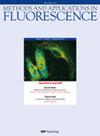Phasor-based multi-harmonic unmixing for in-vivo hyperspectral imaging
IF 2.4
3区 化学
Q3 CHEMISTRY, ANALYTICAL
引用次数: 1
Abstract
Hyperspectral imaging (HSI) is a paramount technique in biomedical science, however, unmixing and quantification of each spectral component is a challenging task. Traditional unmixing relies on algorithms that need spectroscopic parameters from the fluorescent species in the sample. The phasor-based multi-harmonic unmixing method requires only the empirical measurement of the pure species to compute the pixel-wise photon fraction of every spectral component. Using simulations, we demonstrate the feasibility of the approach for up to 5 components and explore the use of adding a 6th unknown component representing autofluorescence. The simulations show that the method can be successfully used in typical confocal imaging experiments (with pixel photon counts between 101 and 103). As a proof of concept, we tested the method in living cells, using 5 common commercial dyes for organelle labeling and we easily and accurately separate them. Finally, we challenged the method by introducing a solvatochromic probe, 6-Dodecanoyl-N,N-dimethyl-2-naphthylamine (LAURDAN), intended to measure membrane dynamics on specific subcellular membrane-bound organelles by taking advantage of the linear combination between the organelle probes and LAURDAN. We succeeded in monitoring the membrane order in the Golgi apparatus, Mitochondria, and plasma membrane in the same in-vivo cell and quantitatively comparing them. The phasor-based multi-harmonic unmixing method can help expand the outreach of HSI and democratize its use by the community for it does not require specialized knowledge.基于相量的体内高光谱成像多谐波分解
高光谱成像(HSI)是生物医学科学中的一项重要技术,然而,对每个光谱成分的分解和量化是一项具有挑战性的任务。传统的分解依赖于需要来自样品中荧光物种的光谱参数的算法。基于相量的多谐波分解方法只需要对纯物种进行经验测量,即可计算每个光谱分量的逐像素光子分数。通过模拟,我们证明了该方法对多达5个成分的可行性,并探索了添加代表自发荧光的第六个未知成分的用途。仿真表明,该方法可以成功地用于典型的共焦成像实验(像素光子计数在101到103之间)。作为概念的证明,我们在活细胞中测试了该方法,使用5种常见的商业染料进行细胞器标记,我们可以轻松准确地将它们分离出来。最后,我们通过引入溶剂化变色探针6-十二烷基-N,N-二甲基-2-萘胺(LAURDAN)来挑战该方法,该探针旨在利用细胞器探针和LAURDAN之间的线性组合来测量特定亚细胞膜结合细胞器上的膜动力学。我们成功地监测了同一体内细胞中高尔基体、线粒体和质膜的膜序,并对它们进行了定量比较。基于相量的多谐波分解方法可以帮助扩大HSI的推广范围,并使其在社区中的使用民主化,因为它不需要专业知识。
本文章由计算机程序翻译,如有差异,请以英文原文为准。
求助全文
约1分钟内获得全文
求助全文
来源期刊

Methods and Applications in Fluorescence
CHEMISTRY, ANALYTICALCHEMISTRY, PHYSICAL&n-CHEMISTRY, PHYSICAL
CiteScore
6.20
自引率
3.10%
发文量
60
期刊介绍:
Methods and Applications in Fluorescence focuses on new developments in fluorescence spectroscopy, imaging, microscopy, fluorescent probes, labels and (nano)materials. It will feature both methods and advanced (bio)applications and accepts original research articles, reviews and technical notes.
 求助内容:
求助内容: 应助结果提醒方式:
应助结果提醒方式:


